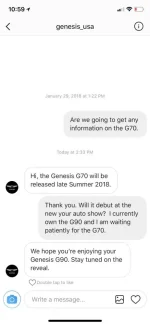Well release date the way I understand it is the date the vechicle is officially a real car available to be sold in what ever country it will be sold in. Then the dealer will be allowed to place orders once a second date is released when Genesis starts accepting orders. Then the time it will take to build and ship those cars to the US in this case. So from release date to the first cars hitting the dealers could be months.
Not sure I understand that.
Here is what I believe happens. It may only be 90% correct, and I welcome clarification from people who know the details pertaining to Genesis or Hyundai, but I think the following is basically the way it works:
Genesis Motors USA (which reports to Hyundai Motor America) determines what the trim levels will be and what options will be included with each trim level, for the USA market. That has probably already been done (hopefully). In the past, the USA trim levels and options for Hyundai Genesis and Genesis Motors GXX have always been different than the ones offered in Korea (and even different in most cases from what is sold in Canada).
When the time comes, Genesis Motors USA orders the cars from Hyundai Motor Korea and selects the quantities of each trim level and color, etc that they want, and when they want them. Obviously, there is considerable lead time required for manufacturing and ocean freight. Genesis Motors USA makes these decisions (especially on quantities) based on their best guess of what will sell, and they might get "some" feedback from dealers on this.
Then Genesis Motors USA lets dealers in the USA reserve specific allocations from among the cars Genesis Motors USA has already ordered from Korea. If dealer requests outnumber the ones available for a specific color or trim level, that will usually affect the
future orders that Genesis Motors USA places with the Korean factory to better balance supply and demand.
Vehicles made in Korea have to be imported by Genesis Motors USA at various ports of entry around the US, and then Genesis Motors USA as distributor may add additional options (like
wheel locks) and create the MSRP window sticker, etc. Then they ship the vehicles to dealers (usually via truck) based on the number of units that dealers have requested, including specific color and trim level requests (if they have enough to accommodate dealer requests). They have to optimize the truck load to a certain dealer or nearby dealer so that it is done in an efficient manner.










